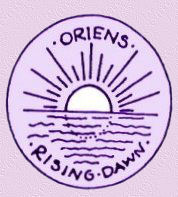O DAYSPRING (Zech 6:12; Lk 1:78),
Splendor of Eternal Light (Heb 1:3),
and Sun of Justice (Mal 4:2):
Come, and enlighten those that sit in darkness,
and in the shadow of death (Is 9:2; Lk 1:78-79).
O Oriens
Oriens: the word is familiar because every morning the Church sings: “Per viscera misericordiae Dei nostri -- literally, through the inmost heart, the secret places of the mercy of our God -- in quibus visitavit nos Oriens ex alto -- in which the Orient from on high has visited us” (Lk 1:79).
Oriens was the name of the ancient Roman sun god, the source of warmth, energy, and light. At the same time, Oriens means the rising sun, the victory of light over the shadows of the night.
From the earliest times, Christians at prayer have turned towards the East. Christ is the Dayspring, the rising sun who dawns upon us from high “to give light to those in darkness and in the shadow of death” (Luke 1:9). The eastward orientation of churches and altars is a way of expressing the great cry of every Eucharist: “Let our hearts be lifted high. We hold them towards the Lord.”
Ad Orientem
When, in the celebration of the liturgy, the priest faces the “liturgical east,” he is “guiding the people in pilgrimage towards the Kingdom” and with them, keeping watch for the return of the Lord. “This Jesus, who was taken up from you into heaven, will come in the same way as you saw him go into heaven” (Acts 1:11). Pope Benedict XVI has reminded us that a powerful witness is given in the prayer of a priest and people who stand together facing eastward and giving voice to the same hope. “The Spirit and the Bride say, 'Come.’ And let him who hears say, 'Come’” (Revelation 22:17).
The message of the Holy Father at Heiligenkreuz Abbey in September 2007 was clear and compelling:
In all our efforts on behalf of the liturgy, the determining factor must always be our looking to God. We stand before God - he speaks to us and we speak to him. Whenever in our thinking we are only concerned about making the liturgy attractive, interesting and beautiful, the battle is already lost. Either it is Opus Dei, with God as its specific subject, or it is not. In the light of this, I ask you to celebrate the sacred liturgy with your gaze fixed on God within the communion of saints, the living Church of every time and place, so that it will truly be an expression of the sublime beauty of the God who has called men and women to be his friends.
Christ, King and Priest
The prophet Zechariah is another source of the antiphon. The Vulgate gives a shimmering image of Christ, the Orient who is our King and our Priest. “Thus saith the Lord of Hosts, saying: Behold a Man, the Orient is his name. . . . Yea, he shall build a temple to the Lord: and he shall bear the glory, and he shall sit, and rule upon his throne: and he shall be a priest upon his throne” (Zech 6:12-13).
Splendour of Eternal Light and Sun of Justice
“Splendor of eternal light” comes from the Letter to the Hebrews. Christ is called “the brightness of the glory of God, and the figure of his substance” (Heb 1:3). “Sun of Justice” comes from the prophet Malachi. “For you who revere my name the sun of righteousness shall rise, with healing in its wings. You shall go out leaping like calves from the stall” (Mal 4:2).
Veni: A Change in the Melody
Today’s O Antiphon is carefully constructed; after three invocations of Christ the Light, the petition begins. But -- surprise! Today’s Great O departs from the familiar pattern: the Veni coming, as it were, out of the depths: do-fa-mi. Today, our Veni has a certitude, a note of triumph, the beginning of a jubilation. It is as if the first rays of the Dayspring are already illuminating our eyes and warming our faces. Today, our cry Veni is sung on la-sol, right after the musical summit of the whole antiphon. Picture this: you have climbed to a mountain peak before sunrise and there, as you survey the dark horizon, you catch the first rosy glimmers of the dawn. From your mountain height you give voice to the cry of your heart: Veni! But the cry comes from one who already sees the light.
The Word Become Prayer
The petition part of the antiphon is taken almost textually from the Benedictus: “Come, and enlighten those that sit in darkness, and in the shadow of death” (Is 9:2; Lk 1:78-79). Behind the text of Saint Luke, of course, lies the prophecy of Isaiah that we will sing at Christmas: “The people who walked in darkness have seen a great light; those who lived in a land of deep darkness-- on them light has shined” (Is 9:2). The extraordinary thing about today’s O Antiphon is that in 5 short lines --3 of invocation and 2 of petition-- there are six biblical sources! There is, I think, no better example of how the liturgy is woven from the very fibers of the Word.

